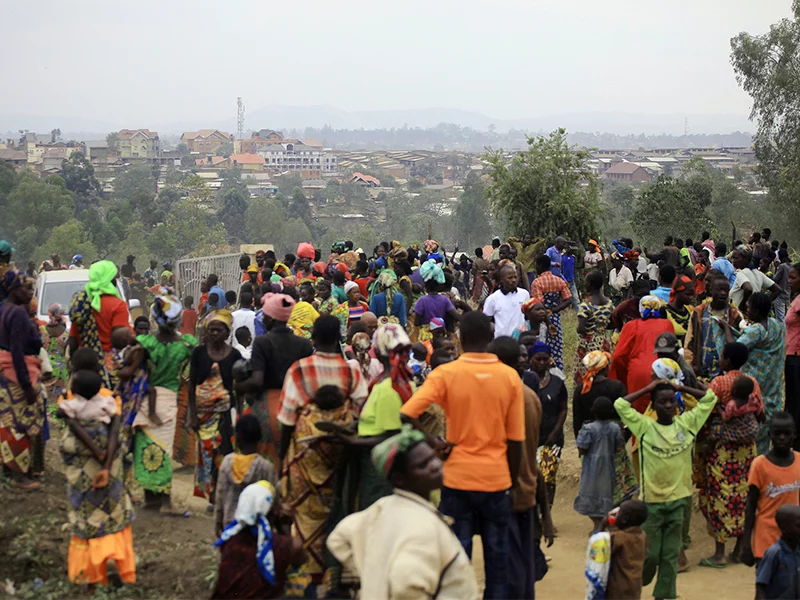Despite being targets of violence, Congolese priests and aid workers continue to confront crisis
Several priests and aid workers have been kidnapped, and earlier this month a priest was murdered. Conflict in several regions has left millions in need.

Roman Catholic leaders in the Democratic Republic of the Congo vowed to continue their work in parishes, schools, and clinics after the murder of a priest in April.
Etienne Nsengiyumva, 38, was killed April 8 after he celebrated mass at his small church in the Goma Diocese. Church sources said the murder was an act of revenge by militia groups in the region who want to silence priests and pastors for criticizing their abuses and plunder of local resources. Part of Nsengiyumva’s mission was to reconcile conflicting communities in the area, where many ethnically based militias operate, said Arsene Masumbuko, a Catholic priest who works for Caritas, a Catholic aid agency.
“Priests are living in fear, but they cannot leave the villages where they are with the people,” Masumbuko said. “They are running schools, hospitals, and peace programs. They are the only hope.”
Church officials have blamed the priest’s death on the Mai Mai Nyatura militia in the North Kivu region, which includes the Goma Diocese. They say at least 15 armed groups operate in the area.
Priests and Catholic churches have long been the target of violence in eastern Congo, where militias have been active since 1993, Masumbuko said. Celestin Ngango was abducted as he prepared to leave his parish after Easter Sunday mass; he was later released. His abductors had called his parish to demand $500,000 ransom and later revised the figure to $50,000. Another priest was kidnapped in North Kivu in January but later released, Vatican News reported.
Read our latest issue or browse back issues.
In other parts of Congo, Catholic bishops have recently been vulnerable after their opposition to President Joseph Kabila’s illegal extension of his second term, which was supposed to end in December 2016. Catholic leaders in 2017 brokered an agreement that allowed him to retain his office until the end of that year and required elections to be held. Kabila flouted the deal.
Churches, convents, and Catholic schools have been vandalized or looted by armed groups in the capital, Kinshasa, the central region of Kasai, North Kivu, and South Kivu. The Catholic Church has paid a heavy price in the insecurity, while it worked for the nation’s good, said Donatien Nshole, general secretary of the National Episcopal Conference of Congo.
“This situation is intolerable,” Nshole said in a statement.
Meanwhile, the situation continues to deteriorate in Kasai, a diamond-rich swath of central Congo about the size of Germany. Until recently, Kasai didn’t rank high on a list of the world’s crises; it wasn’t even high on a list of Congo’s crises. Poor but peaceful, Kasai had no marauding militias or squalid settlements of displaced people, no horror stories of mass rapes and drugged child soldiers. Aligned for decades with the political opposition, Kasai has never been of much interest to Congo’s national government nor a prime recipient of its (limited) largesse.
But that status quo changed in August 2016, when Congolese security forces killed a powerful local chief in central Kasai, touching off a bloody conflict that quickly pulled many other regional leaders and their varied grievances into its orbit. Since then, as many as 5,000 people have reportedly been killed, and about 1.4 million people have fled their homes.
Like Catholic priests, humanitarian workers have also been targeted for kidnapping and violence, according to the Lutheran World Federation, which continues to provide aid, including food, shelter, water, and psychosocial support.
“Last year, 193 security incidents with an impact on humanitarian access were reported,” said Susan Muis, a regional program coordinator for LWF in Central Africa, in a statement. “Several NGOs, including LWF, had to temporarily suspend activities. Some stopped working in the DRC altogether.”
Mennonite Central Committee, a Christian relief and peace-building organization, reported that because of the shortage of aid groups, families who have been less affected by the violence are sharing their resources.
Fidele Kyanza, who has distributed relief items through MCC, said, “Many times, a very poor family is receiving another very poor family into their home.” —Religion News Service; The Christian Science Monitor; with added information
A version of this article, which was edited on May 9, appears in the print edition under the title “Priests, aid workers targets of violence in Congo, yet continue to confront crisis.”






